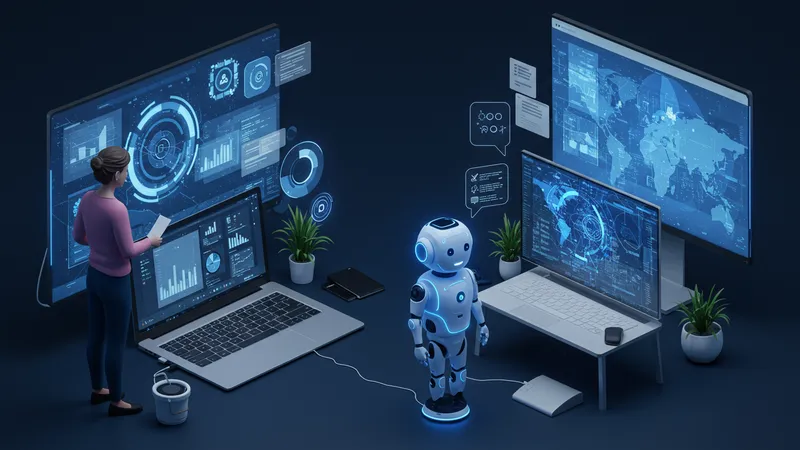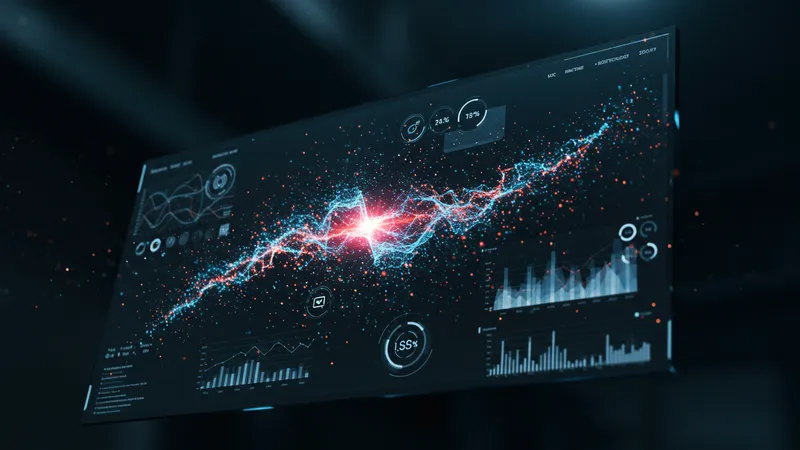In 2025, automation isn't just an option for digital marketing—it's a necessity. With algorithms capable of processing more data than ever before, the strategies that you thought were foolproof are being upended at a relentless pace.
Automation is transforming industries globally, and digital marketing is at the forefront. Marketers must evolve rapidly to keep up, but few are truly aware of how deep this revolution goes.

Traditionally, marketers slogged through hours of manual data entry and complex ad setup, believing this grind was non-negotiable. But with the emergence of advanced automation tools, savvy marketers are reclaiming hours of their day. Imagine scheduling social media posts across five different platforms in minutes, or personalizing customer journeys without breaking a sweat. This might sound revolutionary, but there’s more: tools that analyze customer sentiment in real time. But that's not even the wildest part…
Emerging technologies like AI-driven content creation and predictive analysis are set to redefine how marketing targets customer acquisition. These aren't your average software updates; they predict consumer behavior with eerie accuracy, letting marketers fine-tune campaigns down to the smallest detail. The implications for efficiency and effectiveness are astronomical. Curious yet? What happens next shocked even the experts…
Email marketing seems simple on the surface, yet it's a beast of a task with a monumental potential for return on investment. Enter the era of automation, where campaign precision rivals that of a master chess player. Automation platforms today can craft customized messages that make customers feel uniquely valued, driving engagement through the roof.

What's surprising is how the tools have evolved to predict the best times to reach an audience and even the likely preferred content, reducing the gamble in marketing. For example, using AI, marketers can predict with near-exact accuracy not only when their audience is most receptive but even what subject lines spark interest. But there's one more twist…
Automated email campaigns can also learn and adapt. They tweak strategies based on recipient behavior, constantly optimizing for maximum impact. That means less fumbling with A/B testing and more time capitalizing on the strategies that work. What’s the hidden cost to this advantage? Sometimes, these algorithms know your customer better than you do.
The constant evolution of these tools can make your previous knowledge obsolete almost overnight. Staying ahead demands continuous adaptation. What you read next might change how you see this forever.
Imagine feeding an AI the basic concept of your brand, and it spits out a personalized content strategy lined with headlines, blog posts, and even interactive content—all uniquely optimized for each user segment. Sound too futuristic? It’s happening now. AI-written content, driven by data and crafted to appeal through SEO and click-through prowess, is making waves.

These systems don’t just scrape the internet for trends; they analyze your competitors and adjust the tone to suit your audience. Marketing pros are finding themselves in worlds where copywriters and AI work hand-in-hand. But as powerful as this is, there’s one unexpected downside.
With AI taking charge of content creation, the human touch risks becoming obsolete. There's a growing concern about the loss of emotional nuance, and despite AI's progress, it can overlook cultural subtleties or emerging social cues that resonate personally. However, smart integration of your insights with AI could be a game-changer.
The challenge is for marketers to maintain an authentic voice while leveraging this technology's power. As AI's role expands, the next chapter could redefine “creative expression" in digital marketing. You’ll want to see what's just around the corner.
Predictive analytics is the unseen force behind marketing strategies tailor-made not just to reach but to anticipate customer needs. These tools are capable of analyzing trends, predicting outcomes, and suggesting strategies that align with evolving market demands—before they arise.

The level of insight is staggering. Imagine knowing what your customers will think next week based on interactive behaviors they exhibit today. It transforms how you allocate resources and adapt campaigns to demand anticipated streams. Insider tips? Some companies have seen up to a 30% lift in consumer engagement using these insights!
But predictive analytics isn't infallible. It requires a foundation of accurate data, and feeding it with incorrect, biased, or incomplete information leads to misguided predictions. Marketers are learning the hard way that the data's quality is as crucial as the analytical power itself.
The journey into the predictive realm requires a careful balance between ambition and caution. As more brands discover this tool's efficacy, the race to better and faster analytics is heating up—changing the competitive landscape entirely. The secret sauce to this tool's potential lies just ahead.
The modern marketer’s holy grail: making social media work efficiently without the endless manual updates and engagement tracking. Today’s automation tools have evolved beyond mere posting schedules. These platforms analyze user engagement, optimize ad targeting, and even suggest which visuals will drive the best results.

Social media managers are thrilled at how automation can delve into user behavior at an incredibly granular level. This doesn’t just drive engagement, it cultivates a brand presence that feels effortlessly responsive and deeply personal. But social dynamics might mean even more.
With automation handling routine tasks, marketers can pivot their focus to nurturing relationships and community building. But this freedom could be a double-edged sword. As traditional engagement methods become automated, the personal touch’s value has surged, and brands must be wary of losing this vital connection.
The evolution of social media automation marks a shift—it isn’t about replacing human interaction but enhancing it. By tweaking these tools to amplify your voice and values, the panorama of endless possibilities opens wide. Are you ready for what these platforms will do next?
CRM systems are the unsung heroes of marketing automation, streamlining customer interaction to a level of seamlessness that was sci-fi fantasy a decade ago. These platforms do more than manage contacts; they predict customer needs and identify potential leads before they even express interest.

Today’s CRMs leverage AI to surface insights about client preferences, suggesting personalized content and offers at just the right time. Imagine being three steps ahead of your competitors, always ready with precisely what the client desires. Tempted? Here’s the kicker.
The sophistication of these systems means businesses must balance automation magic against potential over-dependence. Too much automation risks making interactions robotic and impersonal—a perfect segue to push for more integrated AI-human collaboration in client relationships.
The shift from reactive to proactive client relationship management is underway, necessitating new skills and awareness levels. Understanding CRM's expanding role will ensure future marketing successes. Your next click could unravel what's coming for these indispensable systems in 2025.
To truly grasp automation’s influence on marketing, consider real-world examples that highlight its impact. From small businesses scaling rapidly through chatbot-driven support to large corporations revolutionizing customer engagement via AI-powered recommendations, the landscape is fast-changing.

Chatbots, for instance, don’t just answer FAQs anymore—they guide customers through transactions, increasing sales and satisfaction. Statistics show they can resolve up to 80% of queries without human intervention. But there’s a deeper layer to uncover.
The challenge comes when these systems fail to handle unique or complex customer scenarios, highlighting the need for a seamless human backup. It's a striking reminder that while automation paves the groundwork, it’s only through human insight that nuanced brand challenges get resolved.
Case studies illuminate these tools' potential while underscoring the need for balance in technological and human interaction. This blend reveals why personalized marketing remains pivotal. Prepare to be inspired by automation's actual results.
Ad campaigns today surpass strategies of the past, embracing data-driven decisions that maximize returns while minimizing spends. Automation tools help strike that delicate balance, offering insights that shape modern marketing landscapes like wind shapes sand dunes.

Easily overseen details, like budget allocations and audience segmentation, are handled by AI, freeing marketers to focus on the creative tactics that might otherwise be lost amid data overload. Yet again, there’s a twist in this evolving narrative.
Automation platforms offer strategies allowing split-second, on-the-fly modifications against real-time campaign performance. It’s not only about setting a strategy and waiting for results; it’s about the responsive tweaks that prove the magic of human and AI collaboration.
Striking the perfect balance between automated insights and creative innovations stands as the new frontier in ad campaigns. What happens next could redefine the metrics by which success is measured. Reading on may spark yet another paradigm shift in your marketing comprehension.
The promise of automation in marketing is alluring, exploiting vast data pools for unparalleled insights. Yet, its ethical dimensions prompt an essential dialogue. As AI evolves, concerns about privacy breaches, bias, and the loss of human touch have surfaced.

Marketers walk a fine line, ensuring efficiency without infringing on privacy. Intrigue lies in establishing transparent practices while adopting new technologies, destined to affect trust-building with consumers. Intriguing, right? But there’s more to the story.
These systems’ reliance on comprehensive data requires ethical stewardship to avoid misuse, aligning marketing goals with community good. Responsible automation calls for redefining how marketers ethically engage, ensuring customers are allies rather than targets.
The realm of ethical automation represents a bold horizon filled with challenges and opportunities, urging businesses to act thoughtfully. As we peel back these layers, new ethical marketing best practices await you, at the heart of the automation revolution.
Automation and data security have emerged as essential facets for marketers maneuvering in today’s landscape. With such unprecedented access to customer data, automation platforms are tasked with securing sensitive information diligently.

These tools offer security features that, when used properly, can thwart even the most determined data breaches. Implementing these systems requires thorough understanding and transparency, instilling confidence within consumer bases wary of digital exposure.
The tools may handle much of the complexity, yet human oversight ensures these platforms remain vigilant. Without it, automation can potentially mask vulnerabilities. What becomes crucial is the harmony between automated precision and human checks.
The intersection of automation and data security is pivotal, ushering in a new paradigm where robust protective measures and insightful algorithms coexist. Next, we delve into how companies exemplify this balance and navigate challenges that threaten data integrity.
Marketing automation doesn't just boost efficiency—it’s a strategic investment that demands a cost-benefit analysis beyond initial expenditures and subscription fees. ROI quadruples when automation aligns seamlessly with strategic goals.

Businesses are discovering that while upfront automation investments can be steep, the long-term savings in time, resources, and accuracy outweigh initial expenses. Yet there’s more to unravel in this calculation skirmish.
Hidden costs such as adoption time, initial setup, and ongoing training can challenge even the most seasoned marketers. Understanding the full spectrum of these costs allows leaders to make informed decisions balancing outlay with potential growth.
Rather than deterring, these hidden pressures should incite you to scrutinize your automation strategies further, revealing opportunities where automation scales and streamlines efforts. A deep dive ahead awaits, unmasking the potential of informed investments for enduring success.
Adaptive learning represents the next leap in marketing tools, pushing the envelope further than static algorithms. These systems don’t just automate—they learn, adapt, and evolve, perfecting strategies as they process more data.

Their strength lies in adaptability, crafting campaigns that refine themselves like self-healing wounds. Marketers can now lean on this insight to continually optimize efforts, initially perceiving only a fraction of its vast potential.
Adaptive learning tools that pivot rapidly to market trends also necessitate manual oversight. The human element guarantees the tool’s adaptability aligns with brand ethos and customer values, fulfilling its promises without crossing uncharted moral terrain.
The future of marketing will see adaptive learning becoming not a luxury but a staple. Proceed to uncover how this potent mechanism is poised to redefine critical areas in marketing campaigns. The lessons yet learned suggest benchmarks we’re excited to explore.
With current innovations transitioning quickly into standard practice, it’s essential to peek into what lies beyond 2025. Automation is moving toward more intuitive, deeply integrated systems that promise an upheaval mightier than Abrahmalic revolutions.

These future tools will approach every touchpoint with heightened sophistication, offering instantaneous, personalized experiences that will dwarf today’s capabilities. A vision already tantalizing marketing sectors enthralled by impending revolutions signals how much further we can yet go.
Technology will drive a new era focused not merely on tasks but also on creative and strategic dimensions, enabling marketers to craft campaigns interwoven with bold strategies informed by deeper understanding and engagement.
The road ahead is laden with potential and pitfalls alike, demanding constant adaptation and vigilant anticipation as we step into this intricately connected future. How will you keep pace with this monumental shift into 2030 and beyond?
Automation in digital marketing is not just about gaining efficiency—it's about unlocking potential previously thought unreachable. As you venture through these revelations, how will you integrate this radical knowledge into your strategy? Begin sharing these insights with your network and start rewriting the rules of engagement—your future success is waiting.